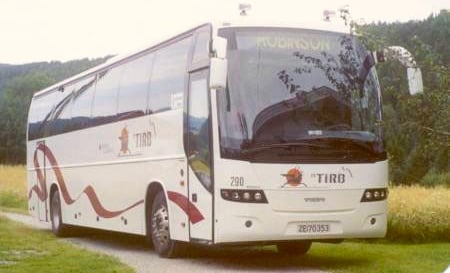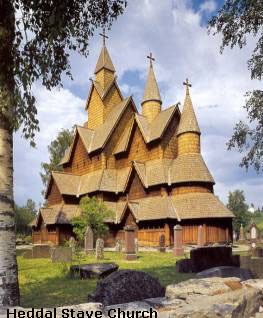Telemark Tour 2002
TOURS
Alice Kirn
11 min read


Our story begins and ends with a missing suitcase and in between sheer fun. There were forty-two of us and Kjetil, the bus driver, whose name only Elaine could pronounce. We came from everywhere it seemed and in various combinations. There were nieces and aunts; grandmother and grandson; husband, wife and in-laws; mother and daughter; mother and son; sisters-in-law; husbands and wives; one family of four and a few singletons. We all had in common a love for Norway and roots in Telemark.
Kathy Ott and I were a niece/aunt combination. It was Kathy's first trip out of the country and her very first flight, so it seemed she was destined to experience in a short time the many anxieties of flight. She was flying out of Minneapolis, and I was flying out of New York. Apprehensive about flying alone, she took comfort in knowing that Elaine Nordlie, our tour guide, would be on the same flight. She wasn't. Kathy boarded, nonetheless, found her seat, and then, along with others, waited out a three-hour mechanical problem delay. She missed the connecting flight from Amsterdam, got switched to another airline, and after a four-hour wait arrived in Oslo without her luggage. By morning it had arrived. Friendly trolls.
Kathy's flight orientation over, a delicious dinner, a meeting with Elaine and Arnold, a walk along Oslo's waterfront, a good night's rest at the Rica Victoria, and the next morning a Scandinavian breakfast that sets one up for the day, we were off with Kjetil for an adventure-packed ten days.
The bus itself and its driver deserve a bit of recognition. Kjetil kept the bus spotless inside and out. Much of each day was spent on the bus, and we rode in air-conditioned comfort with coffee and cold drinks always available. Elaine kept us apprised of our surroundings and on one occasion gave us a quiz to determine just how alert we were. She often shared the microphone so that we could all enjoy a particular story and/or adventure. One especially enjoyable story was Peggy Miller's account of her half-hour one-on-one with the King of Norway.
After a brief tour of the Vigeland Sculpture Garden and the Viking Museum and lunch at City Hall, we headed toward Telemark and our ancestral homes. We had all heard of the stave churches, Norway's architectural claim to world fame, so it was especially exciting when our very first stop in Telemark was at the Heddal Stave Church. The history of this church as well as a personal experience relating to it is detailed in an article by Elaine in the November 2001, issue of Telesoga. It's fascinating reading. Her article also includes information on the nearby Barn Church, so named because the building is on property once part of the parish farm. The Barn Church is used for winter services and many special programs. On another tour, we visited the Eidsborg Stave Church. These all-wood structures, uniquely designed and decorated, date back to the beginning of Christianity in Norway. There were once hundreds of them. About 30 have been preserved. The Heddal church is the largest.
Traveling through beautiful scenery with breathtaking views of Gausta, Lifjell, and Blefjell, and along roads that seemed too narrow for the bus, we made our way to the Bolkesjø Hotel, magnificently located with the mountains towering above. At dinner that evening we were officially welcomed to Telemark by the mayor, Bjarne Bakken, and culture director, Egil Rye-Hytten. Olav Mandt Bakken, director of the Bø Museum, also dined with us, chuckling at our ambitious ten-day schedule. It might have been ambitious, but it was also great to get a taste of many things. It whets one's appetite for a return trip.
After dinner, I couldn't resist coffee on the veranda looking out to the mountains. Another guest, who had spent the day hiking in the mountains, joined me, as she was curious about the large group in the dining room who had just been addressed by the mayor. Among other questions, she asked me, "Is it important to you that you find the homes of your ancestors?" While we talked about the mystery of it all, I nearly missed the evening entertainment. The group had gathered on a hillside terrace overlooking the hotel and were enjoying the music of two Hardanger fiddlers. The program included vocal music and dancing as well. Olav Sem, accompanied by the fiddlers, sang several hymns. Elaine was one of the dancers. Olav had met us earlier in the day and asked Elaine to be his partner. Bit by bit as we went along Elaine's talents unraveled. She sang for us on the bus one day, and on one of the small group excursions played the church organ. She constantly served as a translator and commentator.
Our second day was the thrill of a lifetime for Kathy and me. It all happened by chance. Kjetil stopped the bus for one of those extraordinary scenic views. Ingebjørg Sperre from Notodden was traveling with us. She had been introduced to us as someone who knew every farm in the area. It was only our second day, and, I, among others, was not sure where we were. Kathy, nonetheless, asked Ingeborg if the Einung farm might be in the vicinity. "We are very near," she said, "no more than a mile or two." Arnold Ness, who had the foresight to rent a car in case it might be needed, had also stopped for the view, and Ingeborg had Arne drive us to the farm. What a mesmerizing moment to stand on the ground my great-great-great-grandparents left in 1842!
We were to have a similar experience later in the week when Mary Farrell [a relative I never knew I had] connected with Signe Kvale Rue, an Åmotsdal native [also a relative I never knew I had]. It turns out that Mary, Signe, and I have great great-great-grandmothers who are sisters. Signe, a recently retired headmaster of the Åmotsdal Elementary School, and her son Anders, an illustrator, took us on a rather lengthy hike to the Kvammen farm. This is not a working farm, and there are no roads to it. We hiked through a bit of marsh and brush before we started the ascent to the farm. Once there, Signe pulled coffee and French treats [she had just returned from vacationing in France] from her backpack and served us in porcelain cups. You cannot imagine our joy sipping coffee in porcelain cups on the stone steps of the stabbur, imagining the past, and listening to Signe's delightful stories. This wonderful day included a stop at Anders' house, where he introduced us to his wife and new puppy, served us tea, and gave each of us an autographed copy of Snorre, one of the many books he has illustrated. Once back in Seljord, Signe served us a delicious ham and cheese quiche, followed by cake, coffee, conversation, and introductions to more of the family.
Norwegian hospitality is overwhelming. What Kathy and I experienced was repeated over and over by others who made connections with relatives and with their ancestral farm homes. Beverly Lanning from Wilmar, MN, seemed to have relatives hugging her at every stop. The very first evening in Oslo she had a table full of relatives dining with her. They were having such fun together, and as time went on most of us had similar experiences.
When Kjetil dropped us off at the Seljord School dormitory, where we spent the next six nights, we were at first a bit dismayed even though we had been told that most rooms were for single occupancy and that each floor had one toilet and shower for men and another for women. Nevertheless, Charlotte Danielson pounded the wall in disbelief. Carol Houck said, "A single room; we're still on our honeymoon." [They were married five years ago.] We could not quite fathom how everyone would get showered, get clothes laundered, etc., but it all worked out fine. To play safe Ted Rotenberger arose at 4:30 a.m., for his shower. Our meals made up for any inconveniences. They were wonderful and served by accommodating, cheerful people. After dinner, we enjoyed mile-long walks into Seljord that permitted us to get acquainted with each other and to share experiences. We would all stay here again, even Charlotte and her husband Don, who got locked in his room and stung by a bee -- in his room. The morning chatter up and down the hall was all about Don, unable to get out of his room. Fortunately, he was not allergic to the bee sting, and the kitchen personnel found a ladder, which was put up against his window and used as an exit. By the end of the day's outing, the door was once again functional. Friendly trolls had been at work. Since there were no serious consequences, it was all part of our amusement. We regretted that Lorna Anderson did not get a video clip of Don exiting via the ladder.
As it turned out the Seljord school was a perfect place from which to make our daily excursions. In addition to the farm homes and connections with relatives, we had many, many guided tours. At the Vemork Museum in Rjukan, we learned all about heavy water, the power plant, the German occupation, and Norwegian resistance during World War II. At Morgedal, "the cradle of modern ski sports," we had a tour of the museum and saw where Sondre Norheim, "father of modern skiing," once lived. His statue stands alongside the flame, which has thrice lit the torch for the Winter Olympic games [1952, 1960. 1994]. In Rauland we were introduced to a school for folk art and music, Raulandsakademiet. Some of us watched a class in rosemaling. Others watched a silversmith. The gift shop included items designed and made by the students. At Ulefos Manor we toured the home of the wealthy Danish nobleman Niels Aall [1769-1854]. A 90-year-old relative still lives in the mansion.
Several of our excursions included outdoor museums. At Eidsborg, in addition to the buildings representing centuries past, we were given a tour of the indoor museum, which was devoted to the three main arts of the area: silver making, national costume design, and rosemaling. At Kviteseid we roamed among some of the oldest buildings in Norway, all transported from their original locations. Our guide told us the story of Flektveit, the ancestral home of Karl Emanuel Riis, a friend of Arnold Ness who was traveling with us for the day. Several of the buildings at Kvitseid were from Flektveit, a farm built in 1630 and added to in 1660. We were also given a tour of the stone church, built in the 1100s. It was richly decorated, including pictures of the Danish kings on the walls. The church is used today for special occasions only. Another fascinating museum was Evjutunet in Sauherad with its old ornate furniture and display of Telemark bunads. In Skien, we enjoyed a guided tour of the Brekke Park Museum with its buildings dating from the Middle Ages. Of special interest in this historical collection was a house painted throughout in rosemaling. In Skien, we also visited the childhood home of Henrik Ibsen.
I have already alluded to our good dining. There are yet two meals that deserve special attention. We had a delicious farm dinner at Natadal in Flatdal. Mette Aanderaa welcomed us, and her husband Dag entertained us with charming farm stories entwined with folklore. The meal included lamb, gravy, boiled potatoes, lingonberries, and several other vegetables. When we thought we were finished eating, the food was passed again as though for the first time. Later I learned that this is traditional for formal dining in Norway. We enjoyed a scrumptious cloudberries and cream dessert. The farm would have been a great place to view animals and do a little hiking, but we were pressed for time and had to leave shortly after the meal. I did not even get a picture.
I did get a picture of the luncheon at the Grave farm. These beautiful cakes and breads were made by Gro Grave, Sigrid Straand, and Sveinung Leikvoll. Their children, Gudrun Straand, Eline Øyen Grave, Gunn Kristin Aasen Leikvoll, and Torgeir Straand, performed for us on the lawn while we ate. They all played Hardanger fiddles, and the girls, dressed in their bunads, danced as well. These young people had recently won honors in Norway fiddling contests. In July they appeared in concerts in Minnesota, and Arnold and Elaine had provided them with transportation. The families responded by treating all of us. It was the fiddle festival weekend in Bø, and before the luncheon we had attended a concert. Some of our group attended a dance in the evening as well.
Yet another adventure in Telemark was a dinner cruise aboard the Henrik Ibsen on the Bandak Canal. The waterway extends from Skien to Dalen. We boarded the boat in Ulefoss and glided through beautiful scenery and a series of eight locks on our way to Lunde, where we disembarked.
Shopping. What trip is complete without shopping? Although time was often of the essence, we did find opportunities. On our bus trip back to Oslo, we spent the night at the Rica Ibsen Hotel in Skien and in the morning enjoyed a tour of the Porsgrund Porcelain Factory, with time built in for the gift shop. I have a feeling everybody bought something. I made my big purchase here: a soup tureen in the wheat pattern. Other great shopping places included the ski museum, the silver shop, the Christmas shop, and the stone factory, which featured Norway's national stone, thulite. There were many other gift shops along the way for handcrafted items. In Oslo, we had time to browse in the bookstores and shops as well as stroll along the harbor. In Oslo, at the Rica Victoria where our tour began, we had a final dinner and breakfast together. We had all become friends of each other, and Kathy and I had met a relative we didn't know we had. "Are you related to Elias Stangeland?" Mary Farrell asked on the first day of our tour. I was a little taken aback by the question, as I had never before met anyone who had heard of my great-grandfather. I didn't even know his name myself until a few years ago. "We are related," Mary said, and it turned out we are fourth cousins. At our final dinner, we honored Kjetil, our 27-year-old bus driver, who amazed us all as he faultlessly maneuvered the bus along narrow roads, up and down steep inclines, and around hairpin curves. Beverly let him know that she had fallen in love with him and amused us all by adding, "But I'm too young for you."
Amidst the joy of our last dinner was one unhappy face and an undercurrent of concern, as Darrel Johnson was missing his suitcase. Darrel distinctly remembered putting it on the bus in Seljord. Like most of us, he left his larger suitcase on the bus in Skien where we stayed only one night. Unlike many of us who were staying an additional week or more in Norway, Darrel was headed back to Minneapolis in the morning. Efforts to find the suitcase were in vain, and Darrel left for home minus the gifts for his family. Elaine went with her to the airport as her husband was arriving from Minneapolis at the same time others were leaving. His plane was late, so Elaine went into the restaurant for lunch while she waited. It was during that wait, that she was paged. Kjetil had found the suitcase. It had been taken off the bus in Skien and delivered to the wrong floor. It was too late to get the suitcase on Darrel's flight, but he left Norway knowing it was right behind him. Once again Norway's kind trolls had been at work.
We had a wonderful tour not only with an excellent driver but also with two excellent guides, Elaine Nordlie and Arnold Ness, who were consistently pleasant, accommodating, and untiring. A highlight for Arne on our very last day was an audience with the Prime Minister of Norway, Kjel Magne Bondevik. Shortly after this his picture and an article on Telelaget of America appeared in the newspaper Varden. An earlier issue featured our ten-day tour in Telemark along with a picture of Elaine, Arnold, and Ingebjørg. Plans are now being directed toward the 100th anniversary tour in 2007. It would be great to have the same bus driver and the same guides.


